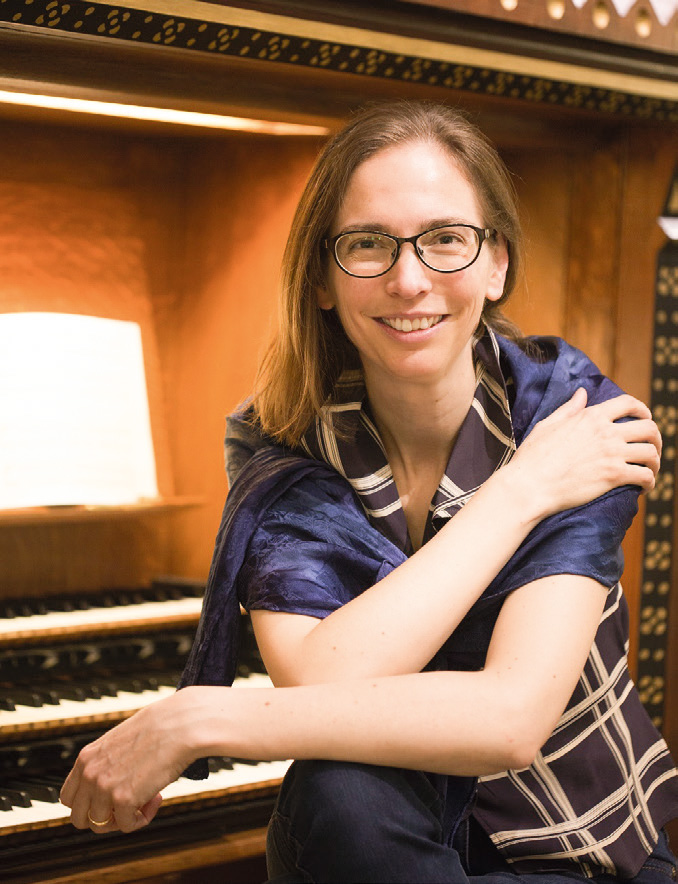Even at the young age of 12, Bine Katrine Bryndorf was convinced that the organ was her future. Today, she holds a professorship at the Royal Academy of Music in London and also serves as Castle Organist at Frederiksborg Castle in Hillerød, Denmark, where she performs on instruments including the world-famous organ by Esaias Compenius (1610) every week.

Bine Katrine Bryndorf was 13 years old when her teacher at the time, the cathedral organist Kristian Olesen, first got in touch with her future mentor Michael Radulescu in order to speak with him about having her study in Vienna. It was the year in which she was also to take part in her first master class with this famous organist. Even back then, it was clear that this talented musician would take the entrance exam at the mdw (at the time still known as the Academy) after she’d graduated from school. She therefore ambitiously set about learning German and attended further master classes given by Radulescu in Lichten-stein and Denmark.
Moving to Vienna at the age of 18 was a big step for the Danish native. “In the beginning, I was alone in a room in the 23rd district; it was a long trip to the Academy from there. And the language was different from what they teach in Danish secondary school German classes,” she remembers. Despite this somewhat rough beginning, the young student was quick to make friends: “There was a wonderful feeling of community among the students in the building on Seilerstätte! We spent the entire day together … in choir rehearsals, in the practice rooms, in the cafeteria, and drinking coffee in our small lounge.” Especially inspiring for Bine were her lessons with Michael Radulescu. “One lesson could lift my spirits and motivate me to practice for an entire week.” She considers Radulescu one of her great role models, for her four years of study and the period she spent as his assistant have had a great influence on her life since then. “If things hadn’t worked out with the organ, I definitely would have pursued music theory.” Later on, Bryndorf also found “wonderful and important” teachers in Gordon Murray, Daniel Roth, and William Porter. “All of them had an influence on the great enthusiasm that I developed not only for making music, but also for teaching.”
To this day, the gifted musician considers herself an artist and a pedagogue in equal measure. In 2017, after making what was probably her biggest professional decision so far—namely, to resign from her professorship in Copenhagen after 24 years there in order to spend more time working as a musician—she began serving as Castle Organist in Hillerød. But shortly thereafter, she received a new job offer from another renowned music school: “I was asked if I wanted to take over the professorship of Susan Landale in London. And now I’m teach four students at the Royal Academy of Music, and I’m extremely happy with that! When she teaches, says Bryndorf, the music frequently goes through far more development for her than it does in concerts because of the special inspiration she derives from the dialogue that takes place in the process. In Austria, it’s not at all uncommon to combine a performing career with teaching; most organists, in fact, combine their concert activities with work in music-focused secondary schools in order to make ends meet. But in Denmark, says Bryndorf, there are over 300 full-time church music posts—and they’re well paid, for which reason taking on a second job isn’t necessary and actually occurs quite rarely. So the challenges faced by organists, she concludes, differ greatly depending on the country they live in. But she goes on to note that what organists do as active performers—as soloists, with a choir, or in orchestral or chamber music works—is the same everywhere. For her part, the prize-winning organist is also fond of performing chamber music, though for this, the harpsichord is instrument of choice. “The harpsichord has greatly enriched my musical world. But the organ has always come first. It captivated me from the very beginning.” Bryndorf has a further constant companion in the form of sacred music. The organ soloist was already active as a church musician during her studies in Vienna, as well as during the entire period thereafter in Copenhagen. And since the summer of 2017, her main job has been as a church musician at Frederiksborg Castle, located north Copenhagen. A further challenge of her profession, says the successful artist, is the notorious glass ceiling: “I didn’t sense any discrimination during my studies; that came only later, on concert tours. Like when I got asked whether I was taking sufficiently good care of my children while out doing my job. I’ve often been quite annoyed at the fact that male colleagues are evidently viewed as good fathers if their wives stay home to take care of the kids, while women are viewed as bad mothers if the fathers occasionally stay home to look after their little ones…” Such questions, she hastens to add, grow rarer the farther north you go. “Things like this are hardly ever viewed as problematic north of Flensburg, because in Scandinavia, there are lots of women who work as church musicians.” But regardless of one’s gender, says Bryndorf, what’s essential is that the love of music and a spirit of contagious enthusiasm support and accompany one’s life. “Wherever these things are encouraged, that’s where you should study—and afterwards, you should work to convey it to the greatest possible number of other people. Because in our present day, there exists a greater need for fantastic musicians and wonderful music than ever before!”

